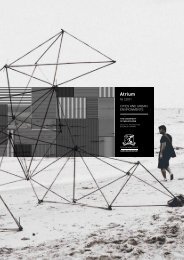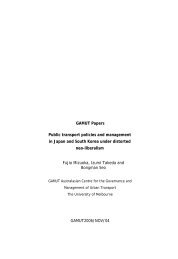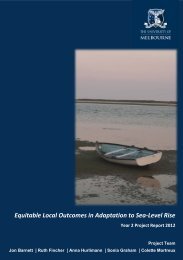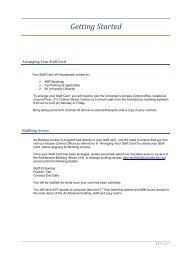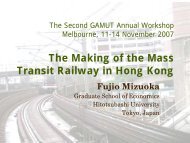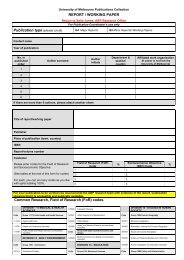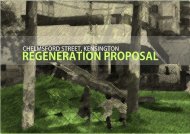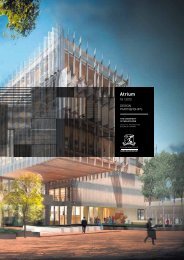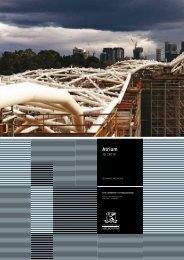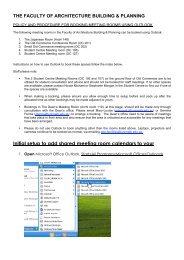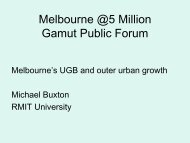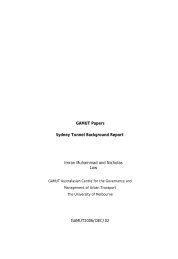May - Faculty of Architecture, Building and Planning - University of ...
May - Faculty of Architecture, Building and Planning - University of ...
May - Faculty of Architecture, Building and Planning - University of ...
Create successful ePaper yourself
Turn your PDF publications into a flip-book with our unique Google optimized e-Paper software.
Atrium13 | 2010PAGE08 | 09THE UNIVERSITY OF MELBOURNEFACULTY OF ARCHITECTURE, BUILDING & PLANNINGThe <strong>Architecture</strong><strong>of</strong> CommunityDr David Nichols,Lecturer in Urban <strong>Planning</strong>Hub, Hall <strong>and</strong> HabitatHow do community <strong>and</strong> the builtenvironment reflect each other? Ourcities <strong>and</strong> towns are rich with evidence<strong>of</strong> attempts to build, <strong>and</strong> then to celebrate,community spirit: buildings <strong>and</strong> spacesdesigned to create, reflect or reinforcethe nature <strong>and</strong> strength <strong>of</strong> social grouping.Many <strong>of</strong> these continue to function todifferent degrees <strong>of</strong> effectiveness; some,like small-scale health or educationbuildings, have pragmatic uses withdefined parameters. Others – suchas halls available for group booking –are multi-purpose. But the ways thatcommunity <strong>and</strong> the built environmenthave interacted over time give us insightinto architectural developments <strong>and</strong>conceptions <strong>of</strong> the architect’s (or builder’s)role, <strong>and</strong> the changing perceptions<strong>of</strong> government, governance, democracy<strong>and</strong> duty.The present-day rhetoric <strong>of</strong> communityis not substantially removed from that<strong>of</strong> a century ago; for many Australians,this rhetoric has clearly reflected realityin many ways. But the built environmentrecord <strong>of</strong> community buildings showsthe many permutations the notion hasgone through since European colonisation.Australia’s community buildings comefrom a number <strong>of</strong> diverse sources: mostcommonly created <strong>and</strong> commissionedby local government, or built by residentsthemselves. The community may alsolobby local government either for a facilityor merely the l<strong>and</strong> to build it on – frequently,through much <strong>of</strong> the 20th century,volunteer labour <strong>of</strong> local residents wouldthen create an amenity which might thenalso be run on a voluntary basis.The Melbourne suburb <strong>of</strong> Kew is perhapsnot an intuitive choice to look for a variety<strong>of</strong> perspectives on the idea <strong>of</strong> ‘community’as it relates to buildings <strong>and</strong> networks.With all due respect to this middle-ring,middle-class suburb, there is perhaps apervading underst<strong>and</strong>ing <strong>of</strong> middle-classsuburbs that they are generally comprised<strong>of</strong> upst<strong>and</strong>ing – <strong>and</strong> rarely outst<strong>and</strong>ing –individuals who look to their own hearthfor contentment, rather than to formingbonds with their neighbours – whether itbe for mutual betterment or social activity.Whether this is true or not (the truth nodoubt resides in examination not <strong>of</strong> peopleor a class per se, but <strong>of</strong> ages <strong>and</strong> lifestages) what is undeniable is that Kewprovides the researcher on community<strong>and</strong> its impact on the built environmentwith a large number <strong>of</strong> unusual examples<strong>of</strong> specific community building types –<strong>and</strong> types <strong>of</strong> community. Kew citizens’scramble, over a century, for a purpose-builttown hall <strong>and</strong> civic centre was surely part<strong>of</strong> the reason behind the creation <strong>of</strong> somany other ad hoc community places;the slow expansion <strong>of</strong> a suburb at thewhim <strong>of</strong> transport planners <strong>and</strong> widereconomic fluctuations may be another. 1How would people <strong>of</strong> Kew meet,communicate, rally or be entertained enmasse in the early 20th century? As wellas the small publicly available space attheir Town Hall – a reconfigured MechanicsInstitute building <strong>of</strong> 1860 – Kew citizensat the turn <strong>of</strong> the last century were ableto use the city’s Recreation Hall, another‘second h<strong>and</strong>’ building built in 1880,acquired by Kew in 1917 from a firm whichhad operated it as a private leisure centre.Like many such amenities, the RecreationHall <strong>of</strong>ten hosted money spinning ‘nights’such as the New Vogue Ballroom, in thelate 1930s. 2While buildings such as the RecreationHall served as Kew’s social <strong>and</strong> communitycentre, those in other areas <strong>of</strong> the suburbsaw the potential for new networks <strong>and</strong>,perhaps, new local government. From the1920s <strong>and</strong> long into the 20th century, theEast Kew Progress Association aspiredto the construction <strong>of</strong> a hall for concerts,dances <strong>and</strong> meetings, to be funded onan ongoing basis by shops at ground level,built on a block it had acquired. 3 Itshonorary secretary, Mr Bl<strong>and</strong>, referringto the wealth <strong>of</strong> the region’s residents,predicted ‘there should be no real difficultyin raising enough money to build a modernhall for Kew people’, adding that ‘the bestway to get this done was to tackle thejob in the true Australian spirit <strong>and</strong> doit themselves.’ 4 The 1930s Depressiondamped the EKPA’s initial surge <strong>and</strong>1. See David Nichols <strong>and</strong> Hannah Lewi, ‘The KewClub: the modernist mythology <strong>of</strong> a middle-ringsuburb’ in Panorama to Paradise: SAHANZConference proceedings Adelaide,September 20072. See for instance ‘New Vogue Ballroom: KewRecreation Hall’ Kew Advertiser 27 <strong>May</strong> 1937 p.33. ‘East Kew progres [sic] hall’ Kew Advertiser12 <strong>May</strong> 1927 p.14. ‘East Kew Progress Association: Successfuleuchre party <strong>and</strong> dance’ Kew Advertiser 26 <strong>May</strong>1927 p.15. ‘Social Events: Kindergarten Dance’ MelbourneArgus 4 July 1925 p.34



